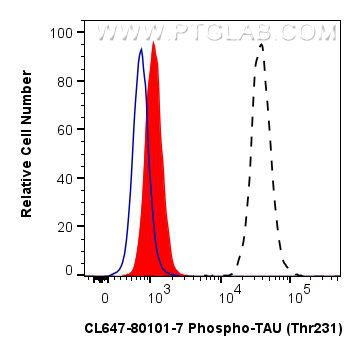Tested Applications
| Positive FC (Intra) detected in | λ phosphatase treated SH-SY5Y cells |
Recommended dilution
| Application | Dilution |
|---|---|
| Flow Cytometry (FC) (INTRA) | FC (INTRA) : 0.25 ug per 10^6 cells in a 100 µl suspension |
| It is recommended that this reagent should be titrated in each testing system to obtain optimal results. | |
| Sample-dependent, Check data in validation data gallery. | |
Product Information
CL647-80101-7 targets Phospho-TAU (Thr231) in FC (Intra) applications and shows reactivity with human samples.
| Tested Reactivity | human |
| Host / Isotype | Rabbit / IgG |
| Class | Recombinant |
| Type | Antibody |
| Immunogen |
Peptide Predict reactive species |
| Full Name | microtubule-associated protein tau |
| Calculated Molecular Weight | 37-46, 79-81 kDa |
| Observed Molecular Weight | 50-80 kDa |
| GenBank Accession Number | BC000558 |
| Gene Symbol | TAU |
| Gene ID (NCBI) | 4137 |
| Conjugate | CoraLite® Plus 647 Fluorescent Dye |
| Excitation/Emission Maxima Wavelengths | 654 nm / 674 nm |
| Form | Liquid |
| Purification Method | Protein A purification |
| UNIPROT ID | P10636 |
| Storage Buffer | PBS with 50% glycerol, 0.05% Proclin300, 0.5% BSA, pH 7.3. |
| Storage Conditions | Store at -20°C. Avoid exposure to light. Stable for one year after shipment. Aliquoting is unnecessary for -20oC storage. |
Background Information
Tau (tubulin-associated unit) is a microtubule-associated protein (also known as MAPT), expressed mainly in neurons of the central nervous system. Its primary function is to modulate microtubule dynamics for maintaining axonal cytoskeleton. The Tau protein has six isoforms produced from a single gene through alternative RNA splicing. Isoforms differ in number of inserts at the N-terminal half and the number of repeats at the C-terminal half (3 repeat-3R; 4 repeat-4R). Tau is hyperphosphorylated during aging and in age-related neurodegenerative diseases such as Alzheimer's disease (AD) and fronto-temporal dementia. Hyperphosphorylation of Tau leads to the formation of neurofibrillary tangles (NFT) in the neurons and glia cells, which is one of the hallmarks of AD.




